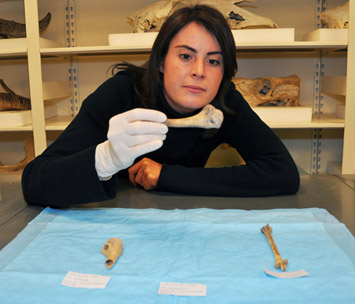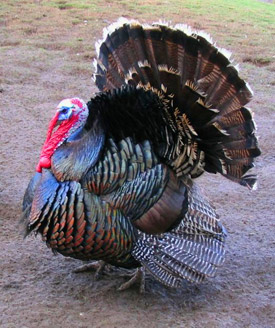From pre-Aztec to plate: York archaeologist tucks into a tale of turkey domestication
Turkeys hold a special fascination for University of York archaeologist Dr Camilla Speller – and not just at Christmas.
Three years ago, as part of her doctoral and post-doctoral studies she was part of a team of international researchers who uncovered evidence of the earliest examples of domesticated turkeys - not in Norfolk - but among pre-Aztec people living in south central Mexico around 800 BC.
She also studied turkey bones unearthed in ceremonial areas of ancient Maya settlements in Central America where the birds were important sacrificial offerings prized for their feathers as much as their meat.
Festive favourite

Dr Camilla Speller examines archaeological turkey bones from the American Southwest
Now Dr Speller, a Marie Curie Research Fellow in York’s BioArCh group, is in the early stages of further research on turkey remains uncovered at major Mayan and Aztec archaeological sites throughout Central America. This latest research aims to improve our understanding of the evolution of the turkey from occasional Mayan and Aztec meal to today’s domesticated festive favourite.
Dr Speller said: “For an archaeologist, turkeys are a brilliant and controlled case study telling the story of the evolution of an animal from wild creature to a domesticated product nurtured and managed by humans.
“For turkeys, this process happened over 2,000 years, a short time span in evolutionary terms. The earliest stages of domestication were confined to a relatively compact geographical area in Mexico, and the Southwest United States. It’s more difficult to track the domestication of dogs or horses for example because their origins are more diverse and their development happened on a global scale.
“The domestication of the turkey gives us an insight into how humans responded to changes in their environment and their changing requirements for food. It helps us to understand the origins of the food we eat today.”
For her latest studies of ancient Mesoamerican turkeys, Dr Speller will be working with colleagues at Washington State University and the University of Florida using zooarchaeological, osteometric, isotopic and ancient DNA analyses of bones and fossilised dung to document turkey use and husbandry among the ancient Maya.
Complex history

Many of today's domesticated turkeys are related to breeds first nurtured by the Aztecs over 2,000 years ago
“The recent discovery of captive-reared Mexican turkey remains in Preclassic Maya sites is interesting because it is outside its proposed native range and suggests a complex history of turkey use and husbandry, perhaps even domestication, within the Maya realm,” said Dr Speller.
“We want to understand when and how this move towards husbanded or domesticated turkeys happened and how wild and husbanded turkeys were integrated into Maya subsistence, ritual and political economies.”
It is thought the early Aztec turkeys were traded into Europe in the early 1500s where new breeds were developed over the following centuries. These breeds were then exported back to the United States where many of today’s commercially-reared broad breasted breeds emerged.
Eaten by millions
Dr Speller, who along with millions of others, will be tucking into roast turkey on Christmas Day, explained: “It is interesting to think that the turkeys we eat today are ultimately descended from birds first domesticated by pre-Aztec people in south-central Mexico over 2000 years ago. Turkeys tell a fascinating story of an animal that has developed from an occasional sacrificial offering to one of our most popular food sources eaten by millions.”
Further information
- Find out more about the Department of Archaeology at the University of York www.york.ac.uk/archaeology
